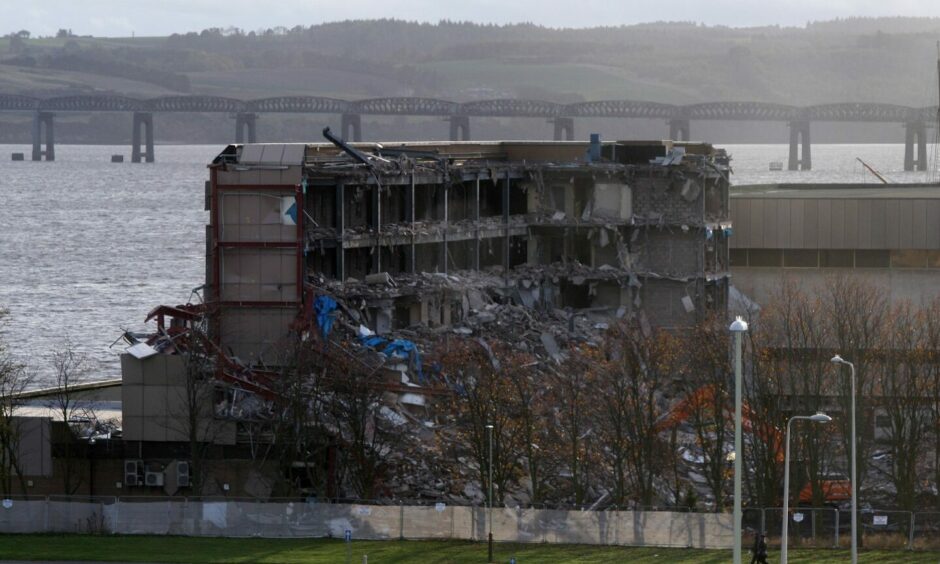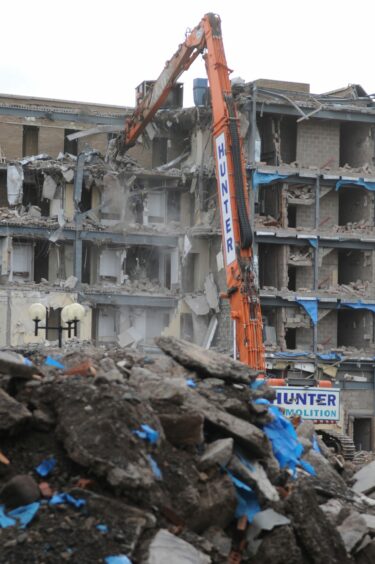
It was the yuppie era of ‘loadsamoney’ when the £5 million Stakis Earl Grey hotel and adjacent Stakis Regency Casino opened at the city’s waterfront in autumn 1987.
Thirty-five years later, none of those buildings remain.
These images from DC Thomson’s archives chart the rise and fall of these landmarks and offer a poignant reminder of how quickly progress can take shape.
The Stakis Regency Casino offered roulette, blackjack, three-card poker and slot games with a bar and restaurant providing food and drink into the wee small hours.
It became extremely popular in the 1980s and 1990s for a work night out!
Across the car park was the Stakis Earl Grey Hotel which occupied an unrivalled site on the banks of the Tay with a stunning vista across to Fife framed by the bridges.
The 129-bedroom hotel employed 130 full-time and part-time staff and was described as a “crucial instrument” in the renewal of Dundee’s waterfront.
Prime Minister Margaret Thatcher officially opened the hotel in March 1988.
Four years after the IRA blew up her seaside convention hotel in Brighton, the car park fronting the waterfront building was sealed off before Mrs Thatcher arrived.
Mrs Thatcher was still the IRA’s number one target in its bomb-and-bullet campaign and police adopted a high-profile security approach for the opening ceremony.
Guests and journalists attending the ceremony were searched by metal detectors.
The hotel was cordoned off by police and Mrs Thatcher arrived on March 30 1988 in a black Jaguar where she was met by Stakis chairman and founder Reo Stakis.
The prime minister was welcomed by a piper before she unveiled a plaque in the foyer which declared the hotel officially open before going on a brief tour of the building.
Mrs Thatcher was shown around the kitchen before visiting the leisure facilities which included talking to youngsters using the swimming pool and whirlpool bath.
She announced that pharmaceutical firm Shield Diagnostics would set up in the city’s technology park and occupy part of the ground originally earmarked for Ford.
Ford announced that because of union squabbles it would not go ahead with the construction of the new facility in Dundee which would have started operations by 1991.
Shortly afterwards Mrs Thatcher spoke at the Scottish Conservative Party conference in the building where she criticised the unions and Labour over the Ford affair.
“We worked extremely hard to get Ford to Dundee,” she said.
“We could not have foreseen that the party which often questions me on jobs in the House would be the very party which ensured that these jobs were stillborn.
“I don’t understand that in this modern age there are some trade unions more concerned with restrictive practices than jobs for their fellow citizens.”
Thatcherism went out of fashion and was followed by 13 years of New Labour.
Hilton took over the hotel and casino in 2000 and it was estimated that the global giants hosted 500 weddings and served more than 1.5 million breakfasts since then.
It was a bustling venue where over the years thousands of people stayed, wined, dined and celebrated in bright, pleasant surroundings.
The hotel was welcoming guests and the roulette wheel still had a few spins left when the Conservatives returned to power under David Cameron in 2010.
The casino bar opened from midnight till 5.30am with a selection of wines, champagnes, spirits, beers and special cocktails, as well as plenty of soft drinks.
A three-course meal cost between £12.95-£18.95 at that time.
The political landscape was changing.
Dundee was also preparing to welcome a new future.
The four-star hotel and casino was now the Dundee of the past.
The hotel and casino were eventually flattened to make room for the £45 million V&A Dundee which was the centrepiece of the £1 billion waterfront regeneration.
Dundee City Council took out a compulsory purchase action costing £8.5 million.
The deal was agreed at a closed-doors meeting of the city council, with the cost being met from the capital budget as part of the £1 billion project.
The casino closed its doors for the final time on February 16 2013 and the hotel checked out its final guests at the end of March 2013.
Its carpets were recycled and used to help disadvantaged people in the Dundee community and its fittings and furnishings were stripped out.
Glasgow-based Hunter Demolition won the £320,000 contract for taking down the buildings which followed the demolition of 37-year-old Tayside House.
Mark Hill, who was overseeing the demolition of both the Gala Casino and the Hilton Hotel, said at the time: “Most of the ripping out of the interior fittings in the Gala is done now.
“And within the next three weeks we will be looking to really get going on the demolition work.
“Once the machines move in, we anticipate it will take three weeks to flatten.
“It will be much quicker than Tayside House, because it’s quite a straightforward demolition. A single-storey building like that is very quick.”
The casino was well-loved in its time.
It came crashing to earth in a cloud of dirt, dust and noise in August 2013.
Only the sign was left standing.
Development convener Councillor Will Dawson said the move was another highly-visible sign of the progress being made on the city’s waterfront.
He said: “This is another important step on the overall project of transforming the waterfront. You can see the change happening before your eyes and I am sure everyone is looking forward to further development in the area.”
Hunter Demolition also demolished the single-storey conference centre at the Hilton before work to pull down the high-rise building started in October.
The five-storey hotel was taken down section by section.
Mechanical excavators took off the roof and the outer walls, leaving a steel frame, which was dismantled before work continued to remove the foundations.
The demolition work was completed before Christmas.
The 26-year-old buildings still had a role to play in the future of the waterfront revolution though with the rubble being used across the £1 billion project.
This was followed by the demolition of the much-loved Olympia Leisure Centre before work started on the construction of the V&A museum.
Construction of the V&A began in 2015.
In June 2017, the exterior of the building was completed when its 2,429 pre-cast concrete panels were lifted into place.
The V&A officially opened on September 15 2018.
A new-look city has emerged from the rubble of the old waterfront including a £38 million new railway station concourse and hotel.
The Tay Road Bridge’s connection to the city road network is another change.
The sweeping curves that previously sent traffic east and west have gone, with on and off-ramps connecting to the multi-lane routes north and south of Slessor Gardens.
The £1bn project was promoted as a major transformation to completely change the lasting impression of the city on visitors and regenerate its economy.
Yet there remains a sense of nostalgia for the old waterfront.






























Conversation